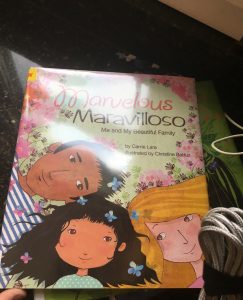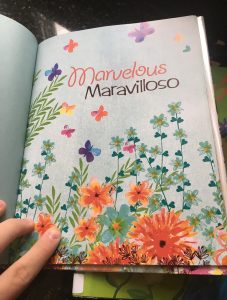Author(s)/ Illustrator/Photographer: Carrie Lara, illustrated by Christine Battuz
Publisher and Year Number of pages: Magination Press, 2018, 30 pages.
Genre: Fiction

Descriptive Annotation: The cover features an artistic rendering of the protagonist with her biracial family, done in some lovely shades of pastel paints that are seen throughout the book. There is the father, a Latino, on her left and her mother, a white woman, on the right as they lay in a field of beautiful pink and red flowers on a pea-green background, and they all have blue flowers in their hair as well in a way that is not disturbing the equilibrium that Mother Nature has set in the scene. As for the book itself, it involves the story of the girl and her family as they navigate their relatively happy lives, pursuing “…the big word diversity-diversidad” (Lara, p. 13). The book is filled with a general bilingual vibe, and Spanish words are peppered into the text as it winds on through the countryside and to the city, where the family goes on a trip. The skin colors of the mother and father are compared, with the mom being called cream, or crema, and the father chocolate. His skin color makes the daughter very happy, and she remarks that it is ”… que rico chocolate!” (Lara, p. 17). This means “what delicious chocolate”, which is a nice message for Latino children who read this book and are looking for representation in an industry that has for too long not extended a hand to people who look like them. There is some background information provided at the end to help the precocious reader and their parents truly enjoy this story, as well learn about the turmoil that biracial couples have historically experienced.
Classroom Application: A central theme is the acceptance of others and appreciation of their differences, and the various descriptions of the family simply living their lives together make this an ideal text to teach this lesson to students. The author and illustrator demonstrate that everything must be done in a harmonious manner when it comes to diversity, and ostracization isn’t the best avenue to pursue when new or different people enter your community. How the children best learn this lesson would be up to the teacher, of course, but the passion shown by the main character in pursuing her goals of living a happy life, as well as loving “her own unique and beautiful color” (Lara, p. 1) are certainly some good lessons for teaching purposes. One possible lesson after reading the book would be to ask students who are perhaps coming out of two different backgrounds if this book reflects their lived experiences (if they are comfortable doing so, of course) and tie that into classroom curriculum. Students will also hopefully recognize, as the main character does at the end of the story, that our differences make us strong on this Earth, and at some point, we all need to realize “that’s not only okay…it’s maravilloso!” (Lara, p. 30).
Linguistic and Cultural Diversity Analysis: The book’s setting is in a very diverse community among the biracial couple that raised the main character, and the unique cultural blend formed in that family unit due to the combination of English and Spanish-speaking cultures from the mother and father, respectively, is depicted and would be great material for a general elementary school classroom, due to the book being geared towards 3-8-year-olds. The traditions of the two peoples that combined to make the family are present in the fabric of the story with the frequent switching back and forth between English and Spanish. Lara explains this concept to the reader through the main character’s family members themselves, which are not only from different cultures but different living areas as well: “My grandma lives in a house surrounded by the deep colors of the forest, y mi abuela lives in the fast and bright colors of the city” (Lara, pgs. 8-9). The contrasts between Spanish and English, city and country, and rural and urban, are never viewed in a negative light; often, they are seen as a strength of the book and a testament to how diverse peoples and communities can get along quite well: “Colors make the world pretty, colors make the world interesting and beautiful. Without them, everything would look the same” (Lara, pgs. 10-11). The main character’s zeal that she derived from her parents to take care of all people and love them regardless of superficial differences are very heartwarming and needed in a world that too often hones in on those differences and uses them as an excuse to discriminate.

